Public Health - Juniper Publishers
Abstract
Adequate knowledge and proper utilization of iodized salt in the household is a significant factor in the prevention of iodine deficiency disorders. This study was aimed at assessing knowledge and utilization of iodized salt and associated factors among the Fitche town community. A total of 470 individuals in the household were participated. About 58.6% of the respondents had good knowledge of iodized salt use and 52.6% use adequately iodized salt. Having higher monthly income [adjusted odds ratio (AOR)=2.97, 95%confidence interval (CI):1.05-8.42], having family health insurance [AOR=2.57, 95%CI:1.15-5.74] and being aware of iodine deficiency consequences [AOR=1.88, 95%CI:1.03-3.40)] were significantly associated with proper utilization of iodized salt. Besides, acquiring health advice on iodized salt [AOR=2.20, 95%CI:1.10-4.40] and educational status [AOR=0.14, 95%CI:0.03-0.56] were shown significant association with the knowledge of respondents on iodized salt use. Even though knowledge of iodized salt use in the study area is higher as compared to other findings, the coverage of proper iodized salt utilization is less than the world health organization recommendation of iodized salt use in households. Therefore, promoting the knowledge and utilization of iodized salt should be strengthened. Additionally, routine testing and monitoring for iodine levels in salt sold in the markets and used by households have enormous benefits.
Keywords: Knowledge; Utilization; Iodine; Salt; Fitche; Ethiopia
Abbreviations: AOR=Adjusted Odds Ratio; COR=Crude Odds Ratio; KM=Kilometer; PPM=Parts Per Million
Introduction
Iodine is an essential micro-nutrient and dietary mineral which is required for human growth, development, and maintenance of normal levels of thyroid hormone synthesis [1]. For the past six decades, iodine deficiency has been recognized as a major public health problem, posing huge risks to the population's health and growth. According to a new global report on iodine status, the number of countries where iodine deficiency is a public health problem has halved over the past decade. However, 54 countries are still iodine-deficient [2]. World health organization (WHO) recommends all food-grade salt used in household and food processing should be fortified with iodine as a safe and effective prevention and control strategy for iodine deficiency disorders [3]. Salt is the most preferable and effective vehicle for distributing iodine to the public because it does not spoil and is consumed in a more predictable amount than most other commodities [4]. According to WHO, the recommended daily allowances of iodine intake is 90mcg for preschool children (0-59 months), 120mcg for schoolchildren (6-12 years), 150mcg for adolescents (>12 years) and adults, and 250µg for pregnant and lactating women [5]. Globally, the problem of iodine deficiency was recognized as a major public health problem affecting billions of people with less developed countries affected more than the rest of the world [6]. In 2020, 28 countries have insufficient iodine in their diets worldwide [7]. Likewise, nearly 1 billion people did not consume iodized salt in 2018 [8]. Insufficient daily consumption of iodine causes a range of functional and developmental abnormalities collectively known as Iodine Deficiency Disorders (IDD) [1]. This Disorder refers to all the ill-effects of iodine deficiency including mental retardation, goiter, reproductive failures such as abortions, congenital abnormalities and stillbirths, mental retardation, impaired mental function [9] hypothyroidism, intellectual disability, psychomotor defects, hearing, and speech impairment [3]. Universal Salt Iodization (USI) is a key strategy proposed by WHO, UNICEF, and ICCIDD to eliminate IDD at the population level [3]. In reality, even though salt iodization programs with high coverage exist, the programs remain vulnerable to changes in the knowledge and practice of the community.
In Ethiopia, the practice of adequate iodized salt use showed a noticeable growth from 15% in 2011 to 89% in 2016 [10,11]. However, inconsistencies of the practice are detected among residences and economic standing [12]. As an illustration, iodized salt utilization is highest in Addis Ababa City [12] and lowest in northern Ethiopia [13]. Concerning the knowledge of iodized salt utilization, the highest prevalence was observed in Addis Ababa City [12] and the lowest was observed in the southern part of the country [14].
On top of the observed discrepancy of iodized salt practice and knowledge at household in the country, further studies to identify the knowledge and awareness of the general population about the use of iodized salt are indicated essential to address barriers in general [4] and particularly in Ethiopia where there are needs to improve coverage of adequately iodized salt [15]. Additionally, the knowledge and practice of iodized salt use appear unknown in Fitche town households. So, the current study aimed at filling this evidence gap by providing significant information on the knowledge and utilization of iodized salt and the reason behind it.
Materials and Methods
Study design and setting
A community-based cross-sectional study was conducted in Fitche town, Oromia regional state from May 01 to June 30/2020. Fitche is the capital town of the North Shewa zone, Oromia regional state, and found to the North of Addis Ababa, the capital city of Ethiopia. According to data obtained from the town municipality, the town's total population in 2019 is estimated to be 44,265, of which 21,000 were males. There are 11,020 households in the town, which is divided into 4 kebeles (the smallest administrative unit).
Study participants and sampling procedures
The source populations were all households in Fitche town. The member of a selected household who is responsible for food preparation and aged ≥18 was considered as a study unit. Individuals (study units) who resided in the study area for at least 6 months were included in the study. The sample size was determined by using single proportion formula, n=((Z1-α/2)2*pq/d2), considering the following assumptions: 52.8% proportion of good knowledge of iodized salt utilization [14], 95% level of confidence, 5% marginal error, and 15% non-response rate. Thus, the final sample size was 440. All four administrative kebele in the town were included in the study. Preliminary household enumeration (census) was done to identify eligible households. Then, the total sample size was allocated to each kebele using proportion allocation to size based on the total number of eligible households in each kebele. Finally, the required sample from each kebele was selected by a simple random sampling technique using a computer-generated number in SPSS.
Data collection technique and instruments
Data was collected using a pretested structured, interview administered questionnaire, and a rapid field iodine test kit was used to collect data from the study participants. Two BSc nurses who have experience in supervision and four data collectors female BSc nurses participated in the study. Rapid test kits were used as semi-quantitative estimations of iodine content. Rapid field iodine test kits manufactured by MINI KITS INTERNATIONAL, India were used to test the iodine content of household salt. A small amount of household salt was obtained from each respondent and Rapid Field Iodine Test Kits were used to test the iodine content. The test was done by adding two drops of the test solution to each salt sample and this was expected to produce light or deep violet color within one minute depending on the iodine content of the salt. The color of the salt was compared to the color chart provided to determine the iodine content. On samples where no color appeared after one-minute, fresh salt samples were obtained and about five drops of the test solution were added. The color was again compared to the color chart to determine the iodine content. Depending on this test, if the iodine content in the salt is ≥15ppm then the salt was taken as adequately iodized. But, if the iodine content in the salt is <15ppm then salt is inadequately iodized [16,17]. After validation of whether the salt is iodized or not, the practice of iodized salt at that specific house was determined and classified as practicing and not. Utilization status was classified as proper and improper after determining whether individuals in the household were using adequately iodized salt (≥15ppm) iodine and use salt after cooking finished. Additionally, knowledge status was determined by using a nine-item question regarding the benefits and risk iodine deficiencies for participants to choose. Those who were able to answer above 50% were categorized as having good knowledge while those who answered less than five correct responses were categorized as having poor knowledge. Additionally, the questionaries consist of different socio-demographic, health system-related, and individual-level factors.
Operational Definition
Knowledge of iodized salt
Respondents who answer half and more than half of the knowledge-related questions were considered as [13,16,17].
Utilization of iodized salt
Refers to a respondent who used adequately iodized salt (≥15ppm) by using a rapid test kit [3,17].
Data analysis procedures
After data collection, each questionnaire was checked for completeness and consistency of the information obtained from the respondent. Then, the data were entered into EpiData manager version 4.4.6 and exported to SPSS version 24 for analysis. Descriptive analysis was done to describe the variable based on their nature. Bivariable analysis was conducted to see the association between dependent and different explanatory variables. Then, all variables with p-value ≤0.25 were considered as a candidate for the multivariable logistic regression model. Backward stepwise multivariable logistic regression was used to identify the predictor variables. Adjusted Odds Ratio (AOR) with the corresponding 95% Confidence Interval were estimated to show the strength of association. Finally, variables with a p-value <0.05 were considered statistically significant.
Data quality management
The questionnaires were initially designed in English and translated into the local language (Afan Oromo) by experts, and then translated back to English by a third person to check for consistency. Data collection instruments were pretested on 10% of the total sample size in Hambiso town which is 12.2 km far from the study area. Accordingly, necessary measures were taken to correct the observed error before entering the actual data collection process. Also, data collectors and supervisors were trained for two days on the techniques of data collection before starting data collection. The functionality of the iodine field test kit was checked during the entire process and proper handling of the kit was also maintained.
Results
Socio-demographic characteristics of the respondents
A total of 430 respondents were participated in the study yielding a 97.3% response rate. The mean age of the respondents was 40.48 years with (SD=10.88). One-third of the respondents belong to age 25-34 years. The majority of the respondents, 149(34.8%) were orthodox religion followers and 264(61.5%) attend formal education with 98(22.7%) of them reported not having a job outside the house. About 303(70.8%) households mentioned husband as a head of a family with nearly one third 145(33.9%), and 101(23.6%) of the participant stating husband and wife were the last decision-makers respectively. In about 134(31.3%) and 48(11.2%) of the household joint husband and wife and relatives were mentioned as the last decision-maker at the household level respectively. Almost half, 213(49.6%) of the household had using iodized salt for less than five years and 195(50.8%) were using it for more than ten years. About 242(62.4%) of the household store iodized salt at home for a period lasting less than two months and the rest 146(37.4%) store for more than two months (Table 1).
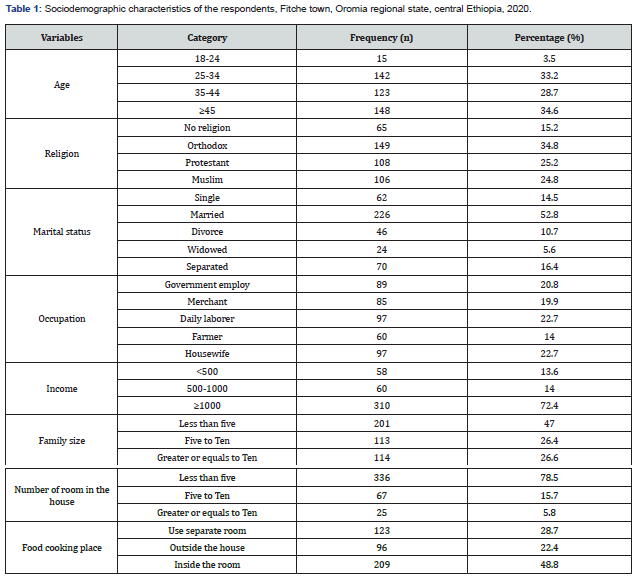
Health system-related characteristics
In this study, about 225(52.6%) of the respondents reside within a five-kilometer diameter from a health facility with slightly more than half, 228(53.0%) of the respondent accessed family health insurance service coverage. Out of the total respondents, 193(45.1%) stated as they have been received advice from health facilities on iodized salt (Table 2).
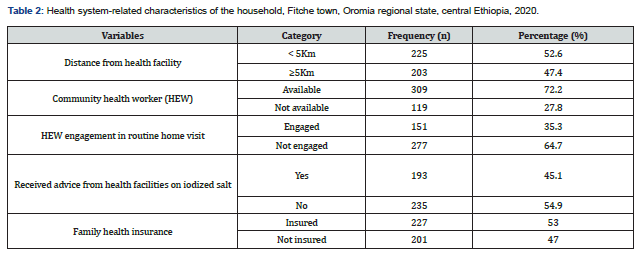
Knowledge of the respondents on the iodized salt use
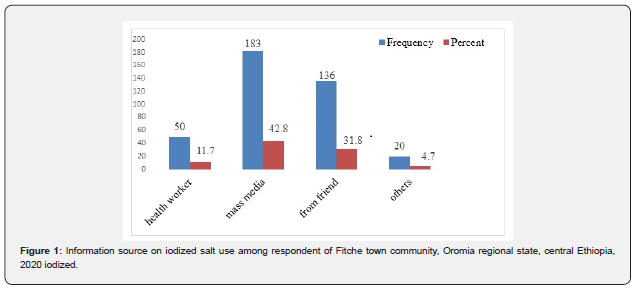
This study demonstrated that more than half, 58.6% of the respondents have good knowledge of the benefit of iodized salt use. About 304(71.0%) of the participants had heard iodine deficiency with only 115(37.8%) of the participants stating some form of health defect/consequences resulting from iodine deficiency. Related to the care of iodized salt more than half (55.0%) of respondents revealed that iodized salt needs more care than other commonly used types of salt. On the other hand, about 82(32.8%), 84(33.6%), and 78(31.2%) of the respondents stated that iodized salt must be stored far from heat, moisture, and sunlight respectively (Table 3). The study also revealed that various sources of awareness related to the importance of iodized salt use among the respondents who have awareness. Accordingly, the majority, 183(42.8%) of the respondents mentioned mass media as their major source of information (Figure 1). On the other hand, a series of questions have been asked the respondents on the importance of iodized salt who were initially aware of iodized salt. Accordingly, the majority 101(26.0%) respond as it prevents iodine deficiency disorder (IDD) followed by goiter prevention 93(23.9%) (Figure 2).
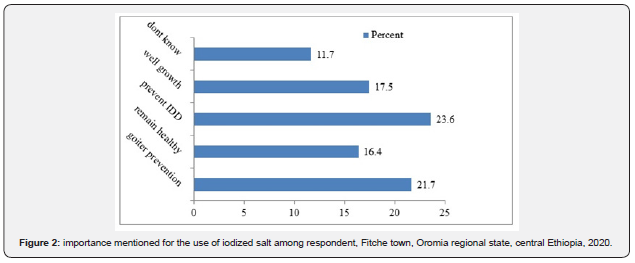

Utilization practice of iodized salt in fitche town community
The practice/utilization of adequately iodized salt i.e., iodine (≥15ppm) in Fitche town household was 52.6%. out of the total participants, 10.3% was not having any iodine content (0ppm) and 37.1% having less amount of iodine (<15ppm) (Table 4).
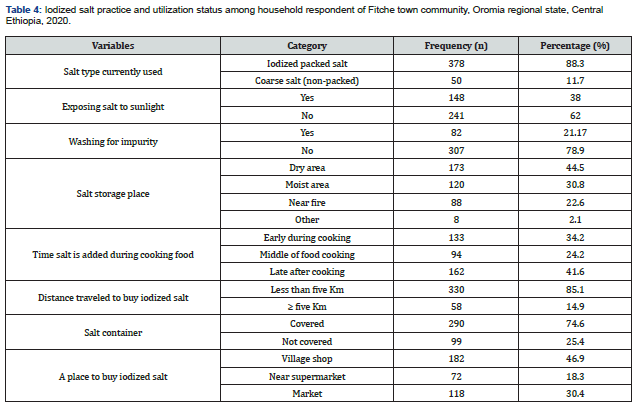
Reasons for non-using of iodized salt
From the total respondents, 71% of the respondent claimed that they heard about iodized salt with around 88.3% revealed as they are using iodized packed salt. But the other, 11.7% reported that they are using coarse salt. Being expensive (22%) and not being salty (24%) were the main reason mentioned for not using iodized salt (Figure 3).
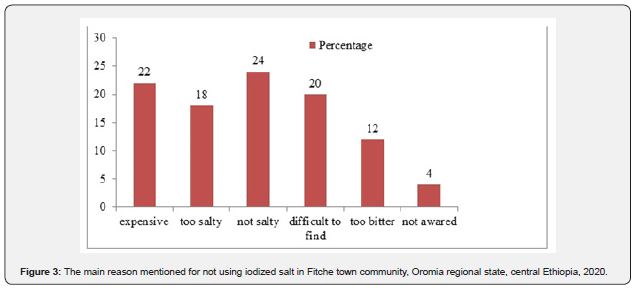
Factors associated with knowledge and utilization of iodized salt
On multivariable logistic regression analysis covariates such as educational status and receive advice on iodized salt at health institution, were significantly associated with knowledge of individuals. Accordingly, individuals who did not attend any formal education were 79% less likely knowledgeable on iodized salt use as compared to those who did attend secondary education (AOR=0.21, 95%CI:0.06, 0.78). Individual who received health advice on iodized salt was more than two times more knowledgeable compared to those who did not receive (AOR=2.20, 95%CI:1.10, 4.40) (Table 5). Furthermore, income level and being aware of the consequences of iodine deficiency were significantly associated with proper utilization of iodized salt. Accordingly, the odds of proper iodized salt utilization were about three times higher in those individuals earning greater than 1000 birr as compared to those individuals earning less than 500 birrs (AOR=2.97, 95%CI:1.05, 8.42). The odds of proper iodized salt utilization were almost two times higher among individuals who have been aware of the consequences of iodine deficiency compared to those who have not been aware of iodine deficiency consequences (AOR=1.88, 95%CI:1.03, 3.40) (Table 5).

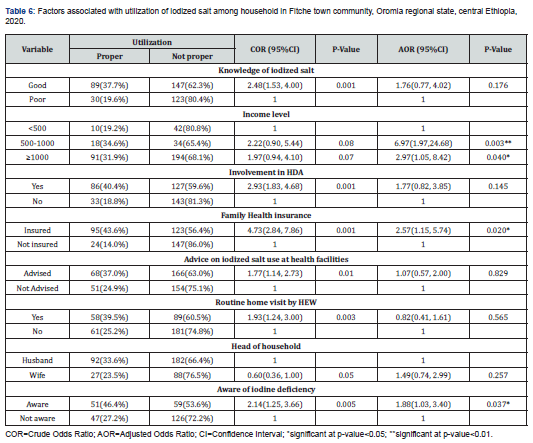
Discussion
This study was aimed to assess the knowledge and utilization of iodized salt in Fitche town community. In this study, 58.6% of the respondents have good knowledge of the use of iodized salt. This finding is in line with studies conducted in Ethiopia (63.8%) [18], Sudan (56%) [19] and India (56.2%) [20]. However, it is higher than the study conducted in different parts of Ethiopia including Mecha district (28.5%) [21], Wolaita Sodo (44.7%) [22], Arba Minch (52.8%) [14] and Debreberhan (53%) [23]. Demographical proximity of Fitche town to the center of the country may increase the chance of accessing information helping in knowledge improvement. Besides, the current study has enrolled only urban dwellers which was found to increase the knowledge level [22]. In contrast, this finding is lower than the study conducted in Addis Ababa (78%) [12], Axum (80%) [24], Ghana (72%) [25], and India (64.6%) [26]. The variation may also be due to differences in awareness creation and educational activities [14]. The differences might be due to iodized salt availability and accessibility in the local market and monitoring concerning the use of iodized salt in those areas [13]. About 52.6% of households in the study area were practicing adequately iodized salt for food preparation. This finding is comparable with the study done in Kore town (56.6%) [13]. On the other hand, this finding is higher than the studies conducted in Wolaita (37.7%) [27], Dabat district (33.2%) (16), Gondar (28.9%) [28], Benishangul Gumuz (26.1%) [29], Laelay Maychew District (33%) [30], and zuway (30.7%) [31]. This discrepancy could be correlated to a change in the time when the studies were done [32]. As evidence from the Ethiopian demographic and health survey, the coverage of iodized salt increased from 28.4% in 2000 to 89% in 2016 [11]. In opposite to the above, this finding is lower than the study done in Saudi Arabia (95.2%) [33] and India (83.1%) [34]. The difference could be due to iodine deficiency has been recognized as a major public health problem in Ethiopia as compared to other countries where the studies have been conducted. Beyond assessing knowledge and utilization of iodized salt, this study also points out predictors of knowledge and utilization of iodized salt. Accordingly, receiving health counsel on iodized salt use was identified as a predictor of knowledge in this population. This might be because health counsel/education has a positive impact on knowledge [35].
The educational status of the respondents was also found to be an independent predictor of knowledge on iodized salt use. This finding was in line with the studies conducted in Arba Minch [14] and Laelay Maychew district [30]. This could be because educated respondents have learned and could read about the importance of iodized salt. This study also identifies independent predictors of proper utilization of iodized salt. So, earning high monthly income was identified as an independent predictor of proper utilization of iodized salt. This finding is in line with the findings from Arba Minch town [14] and Addis Ababa [17]. This might be due to the reasons that families with high income can buy packed salts and have better information about iodized salt [17]. Moreover, family insurance coverage was another factor identified as a predictor of proper utilization of iodized salt. This is possibly due to the insured family have a higher chance of obtaining health-related information which might help them to practice iodized salt utilization properly. In this study, higher odds of proper utilization of salt were observed among households who have awareness about iodine deficiency disorder. This finding is supported by the study Laelay Maychew District [30]. This might be due to the fact that having awareness on how iodine deficiency affects health help to give due emphasis on its proper utilization.
Conclusion
Even though knowledge of iodized salt use in this community is higher as compared to other findings, the coverage of proper iodized salt utilization is less than 90% world health organization's recommendation of iodized salt use in the household [36]. Advice on iodized salt and education status were found to affect the knowledge of iodized salt use at the household level, while income level, family health insurance, and iodine deficiency awareness were independently associated with iodized salt use. Therefore, the town health facilities should provide health education programs to promote the knowledge and consumption of iodized salt. Additionally, routine testing and monitoring for iodine levels in salt sold in the markets and used by households are essential.
To Know more about Juniper Online Journal of Public Health
Click here: https://juniperpublishers.com/index.php





No comments:
Post a Comment